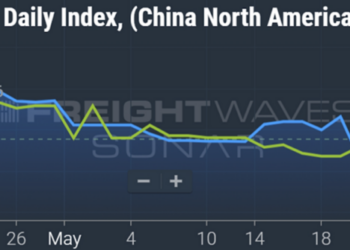Chart of the Week: US Customs Maritime TEUs, Import Ocean Bookings TEUs Index – USA SONAR: CSTEU.USA, IOTI.USA
Container volumes arriving from overseas at U.S. ports are averaging double-digit percentage growth since mid-July. Import bookings, which measure container volumes based on departure dates from the ports of origin, are signaling that growth will probably sustain through August. What are the takeaways from a strong maritime shipping peak season?
Economically speaking
One of the biggest questions circulating in economic circles is over the health of the consumer and consumers’ ability to sustain in what appears to be a worsening environment for their financial well-being. If this is true, in theory there should be some waning in import demand, which heavily skews toward consumer items like appliances, apparel, home furnishings and food.
The reality is, consumers are only in a marginally worse spot compared to last year when looking at the labor market and cost-of-living figures. The one area of substantial difference is their debt levels when compared to wage growth.
The gap between wage growth and revolving consumer debt (i.e., credit cards) has widened, forcing the consumer to be more frugal. This has not necessarily translated to less goods demand from a total volume standpoint. Trading down and buying cheaper replacement items or shifting purchases has filled the void that would normally show up in a recession. There has also been some slowdown in use of credit.
Inventory levels in aggregate have also not risen significantly. On last week’s Freightonomics podcast, Zac Rogers, associate professor of supply chain management at Colorado State University and co-author of the Logistics Managers’ Index (LMI), said there has been slight contraction in overall inventory levels for the past three months. Upstream data suggests that shippers are still operating largely in a just-in-time environment.
The latest reading from the LMI’s inventory level component came in at 49.5 for July, which is just below the breakeven point of 50. This indicates a relatively “fluid” environment for the flow of goods, though there is no doubt that order lead times have increased thanks to service inconsistency and rising costs.
Transportation markets
From a maritime shipping perspective, spot rates appear to have peaked for the moment, according to Freightos Baltic Exchange Indices, but remain in historically high territory. Container shipping rates moving from Asia to North America’s east coast remain stickier than those to the west, as the Red Sea issues appear to be nowhere near concluding. The fact that demand remains up and rates are coming down may be a good sign for shippers looking for some relief.
From a surface transportation perspective, it means to look for continued demand-side pressure around the nation’s largest port cities, especially Los Angeles.
Truckload tender volumes have averaged 23% higher y/y since May out of the Los Angeles market. Tender rejection rates, a measure of carrier capacity, hit close to 9% in June, their highest levels since 2022. Rejection rates have settled significantly since, but September and October are traditionally the strongest demand months for Southern California.
Demand to the Eastern ports is not nearly as robust, though the New York/New Jersey and Savannah, Georgia, complexes both show single-digit growth figures in July and into early August, despite headwinds from the Red Sea conflict.
Loaded container volumes moving on the rail are at five-year highs out of Los Angeles, surpassing pandemic-era levels. It should be noted that port congestion and limitations in infrastructure curbed the rail’s ability to handle more volume in 2021.
The big takeaways are that pull-forward may be less of an explanation for what appeared to be an early maritime peak season than many think as volumes continue to be relatively strong. Transportation managers and providers should be wary of downstream impacts in the next few months, including the holidays.
About the Chart of the Week
The FreightWaves Chart of the Week is a chart selection from SONAR that provides an interesting data point to describe the state of the freight markets. A chart is chosen from thousands of potential charts on SONAR to help participants visualize the freight market in real time. Each week a Market Expert will post a chart, along with commentary, live on the front page. After that, the Chart of the Week will be archived on FreightWaves.com for future reference.
SONAR aggregates data from hundreds of sources, presenting the data in charts and maps and providing commentary on what freight market experts want to know about the industry in real time.
The FreightWaves data science and product teams are releasing new datasets each week and enhancing the client experience.
To request a SONAR demo, click here.
The post Unexpectedly strong import wave keeps rolling through peak season appeared first on FreightWaves.













